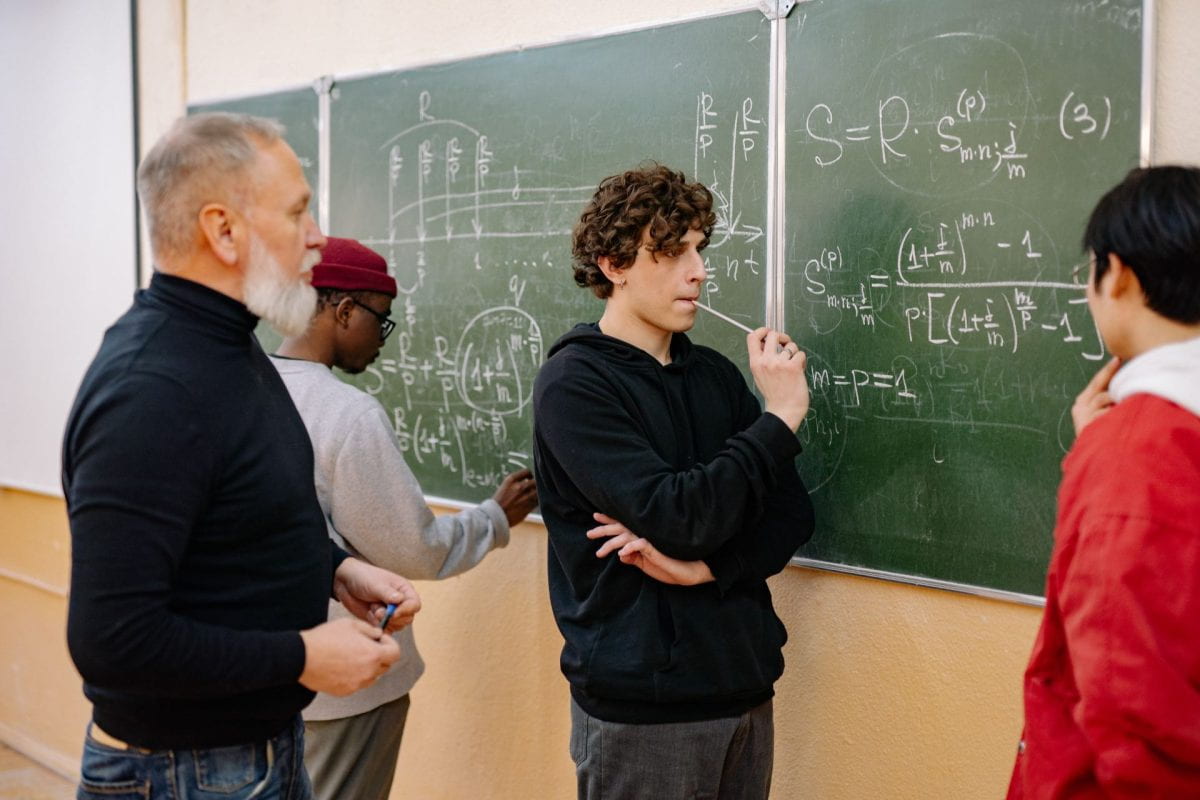Dive into the world of interactive learning! Discover how innovative tools and strategies are revolutionizing student engagement in online education.
Imagine a classroom where discussions aren’t a chore, but a chance to bounce ideas off classmates, explore topics creatively, and even have a little fun. That’s the power of collaboration in action! It explores why working together is essential for learning, the pitfalls of traditional discussion boards, and exciting tech tools that can transform your classroom experience.
Why Collaboration Makes You Smarter
The significance of collaboration in education is highlighted by research conducted by Johnson et al. (2014), emphasizing the advantageous outcomes of peer interaction. Collaboration fosters active learning, where students don’t just passively absorb information, but actively engage with it. It also encourages critical thinking as students analyze different perspectives and social learning as students learn from your classmate’s ideas and approaches (Adams & Wilson, 2020; Bender, 2005). Group work can even make learning more authentic, as students grapple with real-world problems that require teamwork. On top of that, collaborating with others can help combat feelings of isolation, making the classroom a more supportive and engaging environment (Swan, 2017).
Why Some Conversations Can Be Boring
Traditional discussion boards often fall short of achieving the objectives crucial for meaningful student engagement (Brame & Biel, 2015). Common problems highlighted by Bender (2005) reveal why some conversations can be downright boring. These issues include an overwhelming number of discussions, repetitive posting formats (such as the infamous “post once, reply twice” pattern), poorly formulated questions that fail to spark conversation, and lengthy requirements that resemble essays rather than fostering interactive dialogue. Such shortcomings have a detrimental effect, stifling creativity, dampening engagement, and transforming what should be lively exchanges into mundane tasks. Despite being a staple in online education, traditional discussion boards frequently miss the mark in meeting multifaceted educational goals ( Bender, 2005).
However, recognizing and addressing these deficiencies opens the door to unlocking the full potential of online discussions. By understanding the importance of stimulating intellectual curiosity, encouraging diverse perspectives, and fostering an inclusive environment for idea exchange, teachers can transform mundane discussions into dynamic learning experiences (Brame & Biel, 2015). Specific learning experiences can include:
- Stimulating intellectual curiosity among students.
- Encouraging diverse perspectives and viewpoints.
- Facilitating the exchange of ideas in a supportive and inclusive environment.
- Promoting active participation and engagement in discussions.
- Enhancing students’ critical thinking skills through analytical discourse.
- Fostering collaborative problem-solving abilities through interaction with peers.
- Supporting the attainment of learning goals and outcomes through effective discussion facilitation.
The Interactive Advantage: How Technology Breathes Life into Discussions
The good news is that a range of interactive technologies can transform discussion boards from stagnant forums to vibrant hubs of learning. These tools not only encourage participation but also foster deeper engagement and collaboration among students (Bender, 2005).
Imagine a discussion board where active collaborations can be established, and student-to-student interactions are more engaging. Within discussion boards instructors can post or link various resources (written prompts, documents or multimedia). Students then ditch the text box for recorded short responses (audio or video), fostering creativity and engagement. Discussion boards even allow instructors to break students into smaller groups, enabling focused discussions on multiple topics simultaneously (Bender, 2005).

To take the collaboration a step further. Instructors can use various software available to them to empower students to record, explore, and express their thoughts to the forum. This fosters richer discussions as classmates can build upon each other’s ideas and engage with the material in a more interactive way. Whether typing out responses or recording audio/video comments, interactive discussion boards can foster a vibrant and engaging learning environment (Adams & Wilson, 2020). This can be achieved using the following:
- Media Library: Students can record audio responses right within the thread. Students can record a 5 minute audio file. Instructors can use Media Library in the same way. Students, can appreciate the convenience of recording audio directly within the discussion thread, without the use of outside software and equipment. The 5-minute limit encourages concise yet meaningful contributions(Adams & Wilson, 2020). Knowing that instructors can listen to student responses adds a sense of accountability and can motivates students to prepare thoughtfully. When grading student discussion assignments, instructors can record (audio or video) directly into D2L. All recorded audio files can only be up to 5 minutes, but video files can be up to 30 minutes, allowing instructors time to provide a more detailed feedback. Instructors personalized feedback via multimedia can enhance student understanding with the use of thorough explanations and visual aids. This can add more teaching presence and make the grading experience more personable for students (Adams & Wilson, 2020).

- Kaltura MediaSpace: Students can either record within the system or upload files to the system, which can be added to the thread. Videos recorded within Kaltura can be over 30 minutes and audio can be over 5 minutes (Adams & Wilson, 2020). Using Kaltura, students can create engaging video presentations or record audio explanations. This can be empowering to students to offer the option to choose the medium that suits their learning style.
- Microsoft Teams: Teams now have whiteboards that can be developed using either preset templates or created prompts. Instructors can link the whiteboard to the discussion board, allow students to collaborate, then discuss the assignment. Teams’ whiteboards encourage collaboration. Students can collectively brainstorm, sketch concepts, and work on group assignments. It can provide students with the feeling of personal interaction within a virtual classroom where ideas flow freely.
- H5P: Instructors can create interactive learning content, such as a 360 virtual tour, Timelines, Column, and more. Once developed content can be added directly to a forum for student access. This can inject excitement into the learning process and provides students with various ways to engage with the material.
Interactive Activities: Breathing Life into Online Learning
The good news is that a variety of interactive online activities can transform online learning from a passive experience to a dynamic and engaging one (Swan, 2017). Let’s explore four main types of interactive activities:
- Collaborative Learning: This approach focuses on individual learning through student interaction (Johnson et al., 2014). Activities like:
-
- Peer Brainstorming: One effective activity within this approach is Peer Brainstorming. During peer brainstorming, students collaborate to generate ideas on various topics, such as literature reviews, research thesis statements, or presentation topics. This process not only fosters critical thinking but also encourages collaboration among peers.
- Key considerations for successful peer brainstorming:
- Group Preparation: Before the brainstorming session, students should be well-prepared. This includes understanding the topic, doing any necessary research, and having a clear idea of what they want to contribute.
- Desired Outcome: Students should have a shared understanding of the brainstorming session’s purpose. Are they seeking innovative ideas, problem-solving strategies, or creative approaches? Clarifying the desired outcome helps guide the discussion.
- Interaction Expectations: Establish ground rules for interaction. Encourage active listening, respectful communication, and openness to diverse viewpoints. Students should feel comfortable sharing their thoughts without fear of judgment.
- Key considerations for successful peer brainstorming:
- Peer Brainstorming: One effective activity within this approach is Peer Brainstorming. During peer brainstorming, students collaborate to generate ideas on various topics, such as literature reviews, research thesis statements, or presentation topics. This process not only fosters critical thinking but also encourages collaboration among peers.
-
-
-
- Peer Feedback: Madeline & Richards (2016) highlight the benefits of peer review, where students provide constructive feedback to improve each other’s work.
- Tips: Providing a clear template and ensuring feedback is Informative (I), Constructive (C), and Effective (E) enhances the learning experience.
- Group Research: Students collaborate on research projects.
- Considerations: Establish the desired outcome, set expectations for shared tasks, and explore technology tools that can facilitate collaborative research.
- Peer Feedback: Madeline & Richards (2016) highlight the benefits of peer review, where students provide constructive feedback to improve each other’s work.
-
- Cooperative Learning: Here, students work towards a shared goal in a final project. This fosters teamwork, accountability, and communication skills. Activities that foster cooperative learning can include:
- Jigsaw: Students become “experts” on a specific topic and then teach their knowledge to their peers (Brame & Biel, 2015). This promotes active learning and information retention.
- Group Projects: Students work together on a research project or presentation, requiring them to leverage individual strengths and manage group dynamics.
- Simulations: Role-playing scenarios allow students to apply their knowledge in a realistic setting, fostering critical thinking and problem-solving skills.
- Team-Based Learning: This approach emphasizes learning from one another within a team to gain a deeper understanding of a specific topic (Johnson et al., 2014).
- Team Debates: Student’s research and debate opposing viewpoints on a topic, encouraging critical thinking and persuasive communication skills.
- Case Studies: Teams analyze a real-world scenario and develop solutions, fostering problem-solving and decision-making skills.
- Four Corners: Activities like Four Corners ignite spirited discussions, fostering divergent viewpoints and collective learning, encouraging active participation and discussion.
- Considerations: Define clear expectations for group discussion and establish grading criteria for team interaction.
- Problem-Based Learning: Activities center on solving a specific problem, encouraging collaboration and critical thinking. This approach is like collaborative learning but focuses on solving a specific problem rather than a broader topic.
Interactive learning, fueled by technology and engaging activities, holds the power to transform the educational landscape (Swan, 2017). It offers a departure from traditional discussion boards, providing students with dynamic platforms for collaboration and exploration. By embracing the interactive advantage, learners can actively participate, engage with peers, and cultivate critical thinking skills essential for lifelong success.
No matter if you and your students are recording audio and video files or you are creating interactive learning activities for students, our team can assist you with both. If you want to explore how to best incorporate the use of these D2L tools and software in your course, reach out to us via email or through Bookings.
Additional Reading:
For more information on any of the following topics, please check out our previous blog articles.
- Community of Inquiry Model
- Interactive Learning Applications in the Online Classroom
- What Students Can Derive From Purposeful and Deep Learning Discussion Boards
- Engaging Learners in the eLearning Classroom
References:
Adams, B., & Wilson, N. (2020). Building community in asynchronous online higher education courses through collaborative annotation. Journal of Educational Technology Systems, 49(2) 250-261. https://doi:10.1177/0047239520946422
Bender, T. (2005). Role playing in online education: A teaching tool to enhance student engagement and sustained learning. Innovate: Journal of Online Education, 1(4).
Brame, C.J. & Biel, R. (2015). Setting up and facilitating group work: Using cooperative learning groups effectively. Vanderbilt University Center for Teaching. https://cft.vanderbilt.edu/guides-sub-pages/setting-up-and-facilitating-group-work-using-cooperative-learning-groups-effectively/.
Johnson, D. W., Johnson, R. T., & Smith, K. A. (2014). Cooperative learning: Improving university instruction by basing practice on validated theory. Journal on Excellence in College Teaching, 25(3 & 4), 85-118.
Swan, J. (2017). The challenges of online learning: Supporting and engaging the isolated learner. Journal of Learning Design, 10(1), 20-30. https://doi.org/10.5204/jld.v9i3.293
Kampus Production. (2020) Multiethnic students doing research together in library [Photograph]. Pexels. https://www.pexels.com/photo/multiethnic-students-doing-research-together-in-library-5940844/
Alekhya Jonnagaddala, is a Graduate Assistant at the Online and Distance Learning Department at Saint Cloud State University. She is pursuing a master’s in information assurance (MSIA). She has worked in the IT industry for 2 years as a Software Engineer and spends her leisure time cooking.






